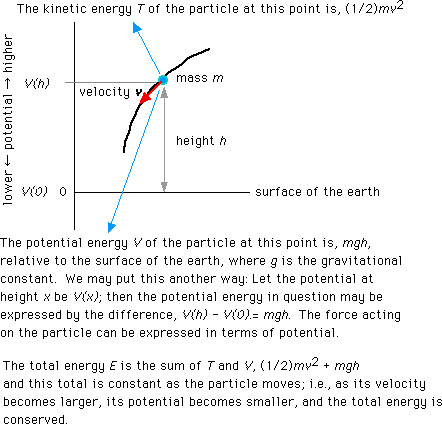

Kinetic Energy and Potential Energy
Kinetic Energy and Potential Energy
The concepts of kinetic energy and of potential energy are very important in mechanics or dynamics. Let's begin with the simplest case, a particle moving on the earth. A particle moving with (uniform) velocity v can do a work; if it hits another particle, it can move the latter. How much work can it do?
Suppose a force F acts along the same direction, for the whole period from the beginning to the end, the total displacement being s (along the same direction). Then the work in this process is Fs. This is the static case.
For a moving particle, its kinetic energy is defined as the total work it can do until it stops; or conversely, its kinetic energy is the total amount of work needed to attain its velocity v, starting from velocity zero. By simple calculation, we can obtain the familar formula, for a particle with mass m; i.e., (1/2)mvv.
Now, recall that gravitation is a sort of acceleration, and hence it is closely related to velocity. If you fall a ball with mass m from the height h, it will hit the surface of the earth, and it will do some work. Thus gravitation produces work! In other words, a particle at a certain height has a potentiality for work, and this is named potential (energy). The higher, the higher potential. The amount of work a particle can do, because of its position, can be measured by the difference of potential at the beginning position and the end position, assuming the value of potential is appropriately defined from the center of the earth to the sorrounding space. See the figure.

The definition of potential energy can be extended to a system of n particles, each with its own mass; and it should be clear that the potential depends on the gravity constant g and the particles's relative configuration (distance between any two particles). Since the potential is measured by the difference between any two positions, absolute values are not necessary; only relative values count.
Notice that for the kinetic energy of the entire world (of the three particles), the same cannot be said. For if the whole is moving (in the absolute space) with some velocity, or rotating with some angular velocity, the value of the kinetic energy becomes quite different. Despite this, the conservation of total energy holds, even for many-particle systems.
Reference
Barbour, Julian (2000) The End of Time, Phoenix, 90-92. [For understanding what Barbour says in these pages, the correct understanding of kinetic and potential energy is necessary.]
Last modified March 30, 2003. (c) Soshichi Uchii